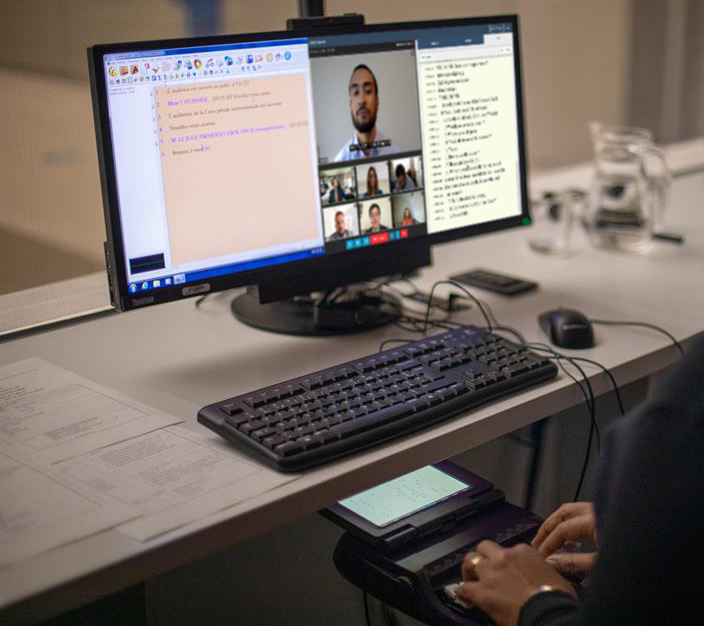The Modernization of Court Reporting Agencies: The Court Reporter
Court reporters are in a unique position, in which they can complete every facet of their job from beginning to end. A reporter can schedule, write the official record, scope, produce, bill, and collect a job if they are working for themselves. However, most reporters do choose to work for court reporting agencies to trim down their responsibilities and take as many legal proceedings as possible. One of the advantages of working for an agency is their access to technology to maximize efficiency. From their steno machines and CAT software to using equipment that results in delivering additional services, technology is also the forefront of the court reporters’ daily lives. Together, the agency and the reporter leverage advancements in technology to increase productivity. This has allowed them to service additional clients and service them as seamlessly as possible.

While the practice of how a court reporter writes on a steno machine has mostly stayed the same, technology has made a large impact to how this process is completed and how long each item takes. For example, the steno machine for a very long time almost simulated a typewriter. The reporter would write on their machines, and the steno notes would print on a slim sheet of paper. This would then be followed by the reporter dictating their steno notes to another person or completing this task themselves. This was a very time-consuming practice, and it also meant that there was no back up of the testimony in a proceeding aside from these notes. For the past couple of decades, steno machines consistently have been upgraded to connect to computers and send the information written on the steno machine directly to the computer in real time. This has led to an increase in efficiency in the editing of a transcript and allowing for multiple backups to ensure the security of the record.
Aside from being able to produce transcripts faster, technology has also given the court reporter access to additional tools to provide services they could not just 15 years ago, such as realtime reporting. Using realtime reporting, attorneys can see exactly what the reporter is writing in real time, increasing productivity in the room. This service started with laptops and additional pieces of large equipment that made it less appealing. However, the technology advanced, and in turn has made providing these services more accessible. From slim, handheld tablets to transmitting a realtime feed to an attendee not in the room, improving its accessibility has been a key to realtime reporting’s popularity increasing over time.
The reporter’s attendance at a legal proceeding is an aspect of the job that did not change for a very long time. In large cities, a court reporter would have to deal with traffic to get from place to place. In more rural areas, court reporters had to travel hours sometimes to meet at a small hotel to conduct a deposition. While attorneys could appear telephonically, the court reporter would always have to be in the room with the witness to obey notary laws in most states. As videoconferencing became more popular, some of these practices started to change. Court reporters were increasingly asked to bring additional technology to legal proceedings such as tablets and additional laptops so that an attorney could see the witness remotely. While some states started to relax some of their laws of reporters appearing in room, but the majority did not, and reporters were still asked to appear physically at a witnesses location. However, using videoconferencing technology led to court reporters becoming familiar with it and assisted in the drastic changes that occurred in 2020.
All the above advances in technology played a part in the way many legal proceedings are being completed today. The pandemic is the turning point where being familiar with technology evolved to a necessity to get the job done. If we were still using paper notes and only appearing at proceedings in person, the legal industry would have completely halted. However, the court reporter was able to pivot, using their laptop or other electronic device to appear at the proceeding, scope and submit a transcript, gather exhibits, and stream realtime. They were also able to limit or remove travel allowing them to take multiple settings in one day instead of spending countless hours in traffic or driving long distances to get to one job. Additional tools allow the reporter to have all the features necessary host a deposition all from one screen. Some of these technologies allow them the ability to download exhibits as well as access to the video and audio immediately after a job, giving them the opportunity to finish their transcripts expeditiously. As technology continues to evolve it enables the modern court reporter to meet the high demand of law firms.

Andre Rojas
Andre Rojas is the Director of Virtual Solutions at vTestify. He brings his 14 years of experience in the court reporting field and is responsible for maintaining operational excellence and ensuring customer satisfaction.
